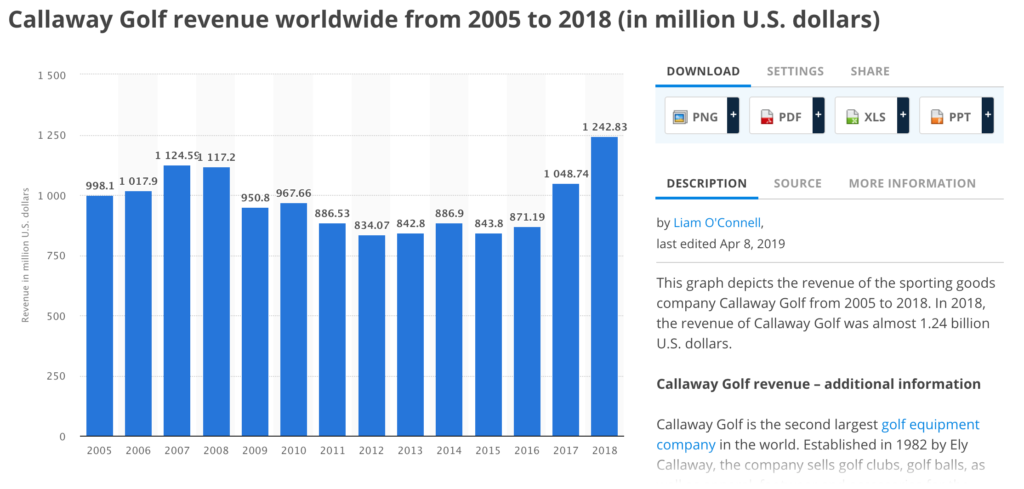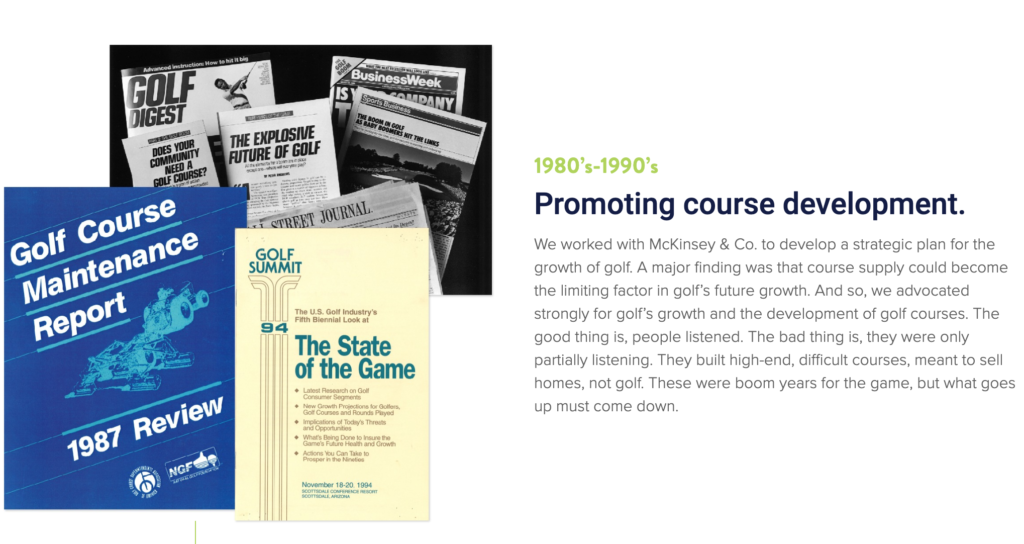The Game is Alright

Let’s get one thing straight: the numbers are never going to work. They’re not coming back. At least not anytime soon.
I’m talking about the swirling brew of statistics that portray golf as an imperiled game, including diminished annual rounds played, the plummeting number of committed players, golf course closings, shrinking memberships, a paucity of new enthusiasts, a landscape of debt and bankruptcy. And so on.
There’s no debate that financial and numerical metrics are far below where they were 15 years ago. But what if the figures used to announce golf’s decline are a false read? Or illusory?
As I wrote previously (Don’t Grow the Game, Preserve the Game), participation and sales numbers are relative. Roughly 24 million people currently play golf in the U.S. including around 19 million who are committed players – approximately the same levels as in the late 1990s (I’m not going to count as golfers the nearly 9 million who only know the sport through Top Golf and simulators).
In pure numbers this is a decrease of 6 million-plus players since a high of over 30 million players in 2003. That sounds debilitating but the framework upon which the loss is based is misleading.
Due to a variety of factors, rounds and participation spiked in the early 2000s but soon began evaporating, indicating the rise was due to unnatural inflation (a bubble) rather than a bullish golf market grounded in solid fundamentals. Basically many new people tried the game for the first time, then moved on.
That ephemeral peak of golf rounds, participation and courses, however, continues to be the baseline golf uses to take its pulse. But 2003 was an aberration — the game’s steroid era — and was never an accurate gauge of golf’s health.

The problem isn’t that the game is 6 million players down – again, golf could never fairly lay claim to those temporary players. The problem is that the major letter organizations and media buy into the assumption that 30 million is the number of participants American golf should have. Under this rationale, any reversion to more normal, and I’d argue sustainable, participation levels is obviously going to seem like a recession.
Conclusion: golf is in a state of disrepair. Print the legend.
The arrogance of this assumption is not only bewildering but delusional. Think about what it really means — that 24 million golf participants in the U.S. is somehow not enough.

Tease that out for a moment. By what incredible standard is 24 million golfers a deficiency? It seems that golf should be able to work with that many players, and I suspect you feel the same — unless you’re a golf operator, an equipment manufacturer, a retail distributor, or a lawnmower or fertilizer salesperson.
There’s the rub. Views of golf’s so-called decline are nearly always refracted through the lens of the golf industry (emphasis on “industry”). Their message is, 24 million participants is not enough to support all the various businesses that attempt to make money and prosper off of the game.
Essentially, golf doesn’t have a participation problem, it has a cash flow problem.
It’s offensive. Golf is a sport, not a business. They are separate things. One is a centuries-old game created to provide a simple form of outdoor entertainment, recreation and competition. The other is a multi-faceted collection of interests that use that game for ulterior, usually self-serving motives.

While golf and business have coexisted almost from the beginning, it was usually with beneficial outcomes for both. In recent decades, however, the balance has shifted toward the forces of business. As companies grow larger, and especially when they begin to support media outlets with ad revenue and develop alliances with associations and legislative organizations, they gain the ability to set the terms of the debate about the state of golf and its future. And as much as they might argue otherwise, those conversations are driven by quarterly earnings reports, not by what is good for the game.
All businesses, large or small, have a fundamental interest in expanding their customer base, and for the largest corporations — the ones with shareholders, the ones wielding the most influence — diminishing or even static sales is not an option. Expansion is the means of survival.
That means creating more participants and bigger markets. In this environment it is strategically primal for businesses and corporations to call attention to golf’s perceived loss of players, which is to say, their own shrinking pool of consumers. The entire golf industry in turn has taken the bait and sent out the clarion call to “grow the game.”
Growing the game does not benefit the game — the game is incapable of caring how many people play it. Growth only benefits business and those who make a living off of golf.

There’s nothing wrong with making a living through golf as an individual or on case by case bases — in fact, it’s inevitable. But the quest for unnatural growth, driven by the insatiable (by definition) need for either increased profit or market placement, pushes golf in untenable directions and is largely responsible for the imbalance the game has allegedly suffered in the first place.
In the 1950s a lack of courses in the U.S. made it difficult for golfers to find places to play, and overcrowding became a serious dilemma. Consequently between 4,000 and 5,000 courses were built during the 50s and 60s, an astounding sum, perhaps, but balanced by over 7 million excited golfers who picked up the sport during the 1960s alone.
A second construction boom that added over 2,600 courses occurred during the 1990s. Now the driver was not a lack of facilities but erroneous reports of a projected participation boom coupled with developers pushing upscale daily fee ventures and the aggressive bundling of golf with suburban and exurban real estate. This time the industry was not responding to consumer demand but attempting to create it.

The economic difficulty so many courses are currently experiencing, not to mention the roughly 200 facilities that have been closing each year in the U.S., is a direct result of the reckless but industry-endorsed overbuilding of the 1990s. The loss of most of these courses is a necessary market correction, unfortunately, but let’s remember there were never enough real golfers to support them. They weren’t needed, shouldn’t have been built and they sapped rounds from previously viable courses.
Aside from the golf facilities bubble, the golf industrial complex has lead the game down some dubious roads, including an industry-wide fetishization of driving distance, bizarre ideas about how to run tournaments, an unwillingness by its guiding bodies to regulate equipment technology, a sad attachment to motorized golf carts, widespread demand for unnaturally green, lush and expensive courses and a professional game that has never looked more alien to the average player.
And then we’re told golf isn’t healthy because it isn’t expanding and falls short of some magic number of players. But the sport was more unhealthy 20 years ago when it was most bloated.
Many serious people have left the game, and for a variety of legitimate reasons: it can be frustrating, overpriced, inaccessible (either physically or culturally), time consuming, environmentally toxic and other things.
This is where the thrust of concern should be, in repairing issues that directly impact the enjoyment of the game, on the golf course. And golf must be okay with not being as popular as some loud voices wish.
In fact, when thinking about how to emphasize and preserve the sport’s most essential qualities of sportsmanship, competition, strategic thinking and the joy of walking through nature, it might be in golf’s best interest to contract further.
When golf gets smaller it condenses to its essentials and strengthens its core identity. Only in this condition, free of superfluousness and unburdened of the whip of business and industry, can it focus its appeal, reassert its architectural voice and remedy lingering service issues.
Golf owes us nothing. It does not need to grow. There are not shareholders or stakeholders. It is not a stock or an investment portfolio that needs to continually compound and pay dividends. If every golf related business ceased to exist the game would still be here. It’s not true of the opposite.
A father at my children’s school was wearing a T-shirt that said “Ability Is Greater Than Disability.” Golf would do well to embrace that sentiment. We’ve been talking far too much about what golf isn’t — about it’s failings, about its losses, about what it gets wrong — instead of what it is. When golf is embraced as a game, an end and not a means, you understand it’s doing just fine.
3 Replies to “The Game is Alright”
Read John Low’s 1912 essay ‘Golf and the Man’. It will sound very familiar.